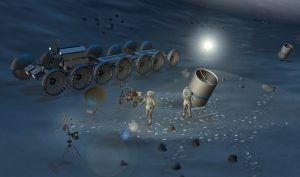The James Webb telescope is unfurling its sunshade. It will take awhile!
And then it starts unfolding the mirror. This is origami on steroids!
The successful deployment of the sunshield will keep the temperature of its instruments just above absolute zero, which in turn will minimize infrared background “noise” in the form of heat from the sun.

The main mirror assembly of the James Webb Space Telescope during testing at a Northrop Grumman facility in Redondo Beach, Calif., last year.
The sunshield maneuver is being performed as Webb speeds toward a spot known as L2, which is beyond the orbit of the moon where gravitational influences are in balance, providing a stable observing post. That journey will take about a month.
The next step major step after deploying Webb’s sun shade is unfolding the telescope’s primary mirror — assembled from 18 smaller gold-coated hexagonal mirrors made of beryllium. Once fully aligned, they will stretch 256 inches, or more than 21 feet, across.


